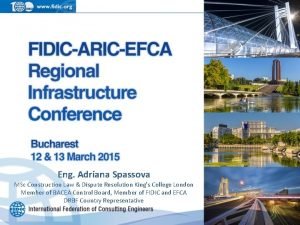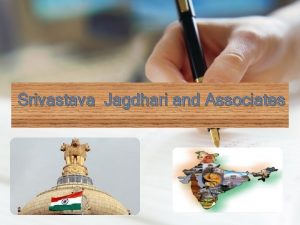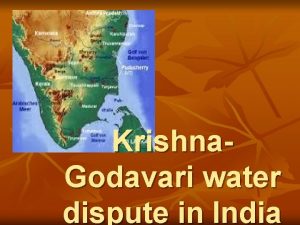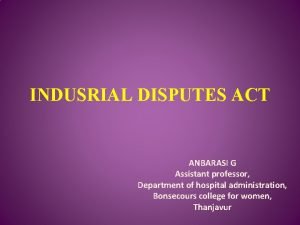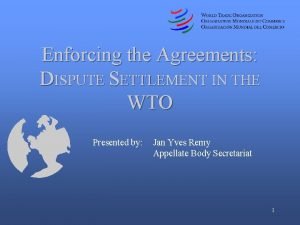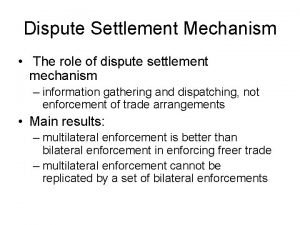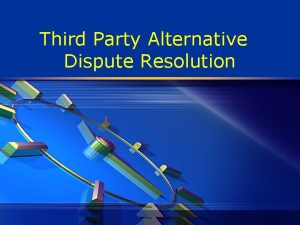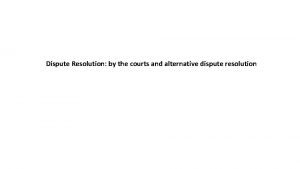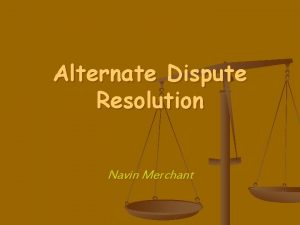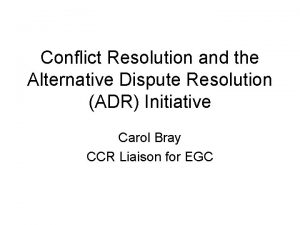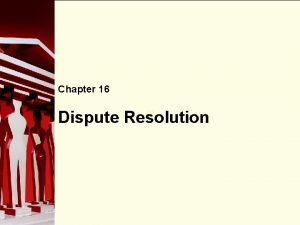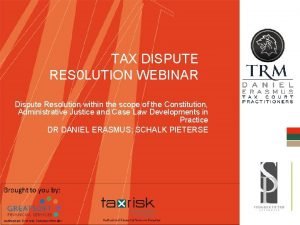Representation of insured and Alternative Dispute Resolution Dispute















- Slides: 15

Representation of insured and Alternative Dispute Resolution “Dispute resolution in national and cross-border conflicts” Dra. Isabel Mendes Cabeçadas Warsaw, 24 October 2007

Conflict Complaint Information Trader or supplier contacted Mediation Invitation sent Declined Accepted Attempt at Conciliation Justice of peace Case filed Agreement Reached Homologated Agreement No Agreement Adhesion Arbitration (award) No adhesion from trader or provider Civil Court Sentence not complied with

STRUCTURE • The Centre is composed of an Arbitration Tribunal and a Legal Advice Service. The latter gives support and supplies information to consumers and traders and tries to solve the conflict via Mediation phase (with sucess in 70% of the cases) • The Legal Service also prepares the complaint processes that will go through to the Mediation, Conciliation and Arbitration phases.

STATISTICAL DATA 2006 3. 167 Total number of complaints Information (In person, Written or by phone) Cases prepared 2. 191 (69%) 976(*) (31%) Total 887 (91%) Cases solved (Mediation, Conciliation and Arbitration) 217 (22%) Awards THE PARTICIPATION OF BUSINESS IN CONFLICT RESOLUTION Collaboration Non Collaboration Adhesions (*) 189 - Financial Services (Banks, Insurance and Credit) 887 48 (5%) 1. 014

COMPETENCE: The legal service separates cases in accordance with the tribunal’s competence which only considers a claim as a consumer conflict, if: • 1 st - it arises out of the supplying services on the part of providers to consumers according to the framework of law; • 2 nd - the value at stake does not exceed € 5, 000. 00; • 3 rd - the conflict has its origin in the acquisition of services purchased in the Metropolitan Area of Lisbon (19 towns)

PROCEDURE The simplified procedure of arbitration used by the Centre is due to some characteristics of Law 31/86 on Institutionalised the access of consumer conflicts to rapid, effective and free-of-charge justice • Celerity - Due to the procedures used which dispense with almost all Judicial Court formalities, the average time between the admission of the complaint to the Centre and the solution of the conflict is 20 to 30 days. • Effectiveness - The judgments of the Arbitration Tribunal have the same legal force as judgments pronounced by Judicial Court. • Free-of-charge - The financial support of the several national state bodies involved, has made it possible to dispense with costs throughout the process. This includes the enforcement phase, if needed at the Judicial Court. Expertise - is paid by parties with some support from the Traders’ Union

RESULTS 2006 5% 22% 9% 69% Information Mediation 69% Awards Non collaboration of Business (not solved) In progress

Cases Solved Mediation, Conciliation and Arbitration • 1989/90 Statistics - November 20, 1989 to December 31, 1990 • 1991 to 2006 Statistics relevant from January 1 to December 31 of each year

PRINCIPLES The procedure used by the Centre fully complies with the principles laid out in EC Recommendation of 30 March 1998: Principle of Independence Principle of Transparency Adversarial Principle of Effectiveness Principle of Legality Principle of Liberty Principle of Representation and the principles of equality of all parties and material truth

• The Principle of Independence: the Arbiter-Judge is a magistrate nominated by the High Council of the Judiciary; the competence and experience gained as a magistrate guarantees the degree of impartiality necessary for arbitration work, in such a way as to gain the complete confidence of the parties along with consumers and traders. The Principle of Transparency: whenever so requested, the Lisbon Centre will always provide information on the types of cases which can be submitted to the Arbitration Tribunal; the nature and form of the Arbitration Tribunal cases are in the public domain (sentences and statistics).

• The Adversarial and Oral Principle: the defendant receives a copy of the complaint as soon as possible, to enable him to contest it either in writing or orally in front of the Judge; the Judge hears both parties before making a final decision, thus guaranteeing strict observance of the principle of contradiction The Principle of Effectiveness and Enforcement: according to the Law of Voluntary Arbitration, the decisions of the arbitration tribunal have the same legal value as judgments by a court of law. The Principle of Legality: the decisions of the arbitration tribunal are based on the law, namely on the legislation on communitarian directives on consumers' rights.

• The Principle of Equality of all Parties: both parties are assured of equal status and treatment throughout the procedure; this is in real terms and not merely formal, and covers the parties’ exercising of their faculties, the use of means of defence, evidence, presenting witnesses, etc. Principle of Material Truth: because the arbiter may know the real matter, unlike what happens sometimes in judicial courts.

What is FIN-NET? • FIN-NET is an out-of-court financial complaints network in the European Economic Area. • Linking existing ADRs with national competence. • In the area of financial services. • Banking • Insurance • Credit

How does it work ? financial dispute financial provider consumer decision contact Information foreign scheme competent scheme Co-operation nearest scheme

“The Arbitration Centre is a Court that is closer to people” Prof. Jean Calais-Auloy Magistrates Formation Course, Paris, Out/92
 Msc in construction law
Msc in construction law Self funded vs fully insured
Self funded vs fully insured May lose value
May lose value Not fdic insured may lose value
Not fdic insured may lose value Not fdic insured may lose value
Not fdic insured may lose value Not fdic insured may lose value
Not fdic insured may lose value Alabama home builders fund
Alabama home builders fund High resolution low resolution
High resolution low resolution Delay and dispute mitigation
Delay and dispute mitigation Wages act 1936
Wages act 1936 Krishna godavari dispute
Krishna godavari dispute Objectives of industrial dispute act 1947
Objectives of industrial dispute act 1947 Wto dispute settlement mechanism
Wto dispute settlement mechanism Dispute settlement mechanism meaning
Dispute settlement mechanism meaning Right dispute
Right dispute Objectives of industrial dispute act 1947
Objectives of industrial dispute act 1947
